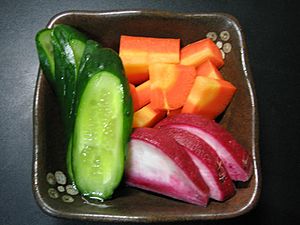Nukazuke facts for kids
Nukazuke (糠漬け) is a special type of Japanese preserved food. It's made by soaking vegetables in a mix of fermented rice bran (called nuka). This method was first used in Japan way back in the 1600s.
You can use almost any vegetable for nukazuke. Some popular choices are eggplants, daikon (a type of radish), cabbage, carrots, and cucumbers. The taste of nukazuke can be different depending on how it's made. It might be a little tangy, very sour, salty, or even strong-smelling. But it usually has a nice crispy, crunchy texture. Sometimes, people in northern Japan even make nukazuke with fish like sardines or mackerel.
Pickles are a big part of Japanese meals. They are often eaten at the end of a meal and are thought to help with digestion. Nukazuke is good for you because it contains special lactic acid bacteria. These are like friendly probiotics that help keep your stomach and intestines healthy. These good bacteria also help make important vitamins, like folate and vitamin B12, in the nukazuke. Plus, nukazuke soaks up nutrients from the rice bran, making it high in vitamin B1. This vitamin was very important in the 1600s in Edo (which is now Tokyo) because it helped prevent a disease called beri-beri.
In the past, people used wooden tubs made from Japanese cedar to ferment their pickles. Today, it's more common to use containers made of ceramic or plastic.
Contents
Making Nukazuke
Starting the Nuka-Bed
To start, rice bran is mixed in a pot with salt, kombu seaweed, and water. You can also add other ingredients to this mix. Things like ginger, beer, sake, chiles, garlic, or even peels from persimmons or apples can be used. Powdered mustard seed is another option. These ingredients give the nukazuke its special flavor. They also help the fermentation process begin and stop bad germs from growing.
The mixture you make is called nukamiso or nukadoko. It feels a bit like wet sand or cooked oatmeal. For the fermentation to work, you need tiny living things called lactic acid-producing bacteria. These usually come from the skin of the vegetables you use or even from your hands. To get the nuka-bed started, you add vegetable scraps, apple peels, or persimmon peels every day for a few days. This helps the good bacteria and yeast grow. Once these tiny living things are active, the nuka-bed is considered "live."
Keeping the Nuka-Bed Healthy
It's very important to stir the nuka-bed well every day. This stops it from going bad, getting moldy, or attracting pests. Stirring helps keep the right amount of acid and salt, and it adds oxygen. This stops harmful germs from growing in the bed. Most people recommend stirring the nuka-bed with clean, bare hands. If you can't stir it every day, you can store the nuka-bed in the fridge for up to two weeks.
Once the good bacteria are active, the nuka-bed will start to have a unique smell. Some people describe it as "yeasty" or "earthy." At this point, you throw away the starter vegetables. Then, you can bury the vegetables you want to pickle in the nuka-bed. They can stay there for just a few hours or even several months for a very strong flavor. Some people say to pickle for no longer than a month. Others suggest that pickles can stay in a well-cared-for nuka-bed for years! If the nuka-bed smells "sour" or "stinky," it might mean there's a problem.
Maintaining Your Nuka-Bed
You'll need to add more rice bran and salt to the nuka-bed from time to time. Some people also suggest taking out a bit of the old nuka when you add new. The vegetables you pickle usually provide enough water for the bed. If you take good care of a nuka-bed, it can last forever. Many families even pass their nuka-beds down through generations. Older nuka-beds are special because they have a very rich and complex flavor.
The flavors and smells of nukazuke can change from day to day. This is because the tiny living organisms are always active. The fermentation process also slows down when the weather is colder.
Serving Nukazuke
When the nukazuke pickles are ready, you take them out of the bed. Then, you wash them in cool, clean water, slice them, and serve them. They are usually eaten as a side dish with savory meals.
Sometimes, people use weights made of metal, stone, or even jugs of water on top of the nuka-bed. This pressure helps to squeeze water out of the vegetables and makes the fermentation happen faster.
It's good to know that nuka-beds can pick up subtle smells from their surroundings. So, it's best not to store them in damp or musty places.
Takuan is a type of pickled daikon radish, and it's also a kind of nukazuke. Traditional takuan uses daikon that has been dried in the sun. However, many mass-produced takuan today use sugar to make the pickling process faster.
See also
 In Spanish: Nukazuke para niños
In Spanish: Nukazuke para niños


